Adam Yamey's Blog: YAMEY, page 171
February 8, 2021
Where Engels dared to tread: Sylvia Plath, Jose Rizal, and Friedrich Engels
AT THE FOOT OF PRIMROSE Hill, there is a lovely street called Regents Park Road, which we have visited many times before, but it was only today in late January 2020 that we spotted the former residences of two famous people and one less well-known in this country, but very important in his own country.
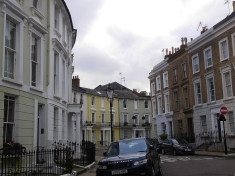 Chalcot Crescent
Chalcot CrescentThe highly regarded American poet Sylvia Plath (1932-1963) lived briefly in picturesque Chalcot Square, which is a few yards south of Regents Park Road. There is a plaque on number three that records that the poet lived there between 1960 and 1961. Married to the poet Ted Hughes (1930-1998), the couple moved in to the top floor flat, somewhat cramped accommodation, in January 1960. It was here that their daughter Frieda was born a few months later. Plath described the square as:
“…overlooking a little green with benches and fences for mothers and children … five minutes’ walking distance from Primrose Hill and beautiful Regent’s Park”
It is still an attractive square, made even more appealing by the variety of colours of the 19th century houses surrounding it. The Hughes’s moved to larger accommodation in nearby Fitzroy Road where she took her own life. Although Sylvia lived longer at Fitzroy Road than in Chalcot Square, her children decided it would be best to commemorate her time in the square. When the plaque was placed on the house on Chalcot Square in 2000, her daughter Frieda was asked why it was not placed on the house in Fitzroy Road. She replied:
“My mother died there … but she had lived here.” (both quotes about Plath from: www.hamhigh.co.uk/lifestyle/heritage/poet-sylvia-plath-she-died-there-but-she-had-lived-3438440)
Plath lived for about a year in Chalcot Square, but the Filipino national hero Dr Jose Rizal (1861-1896) spent even less time in the neighbourhood in number 37 Chalcot Crescent, a sinuous thoroughfare. He stayed in London from May 1888 to March 1889. He came to the metropolis to improve his English; to study and annotate a work by Antonia de Morga (1559-1636) about the early Spanish colonisation of the Philippines; and because London was a safe place to carry out his struggle against the Spanish, who were occupying his country (www.slideshare.net/superekaa/rizal-in-london-52133406). At Chalcott Crescent, he was a guest of the Beckett family. While lodging with the Becketts, Jose had a brief romantic affair with Gertrude, the oldest of the three Beckett daughters. When her love for him became serious, Jose left London for Paris. Before he left, he gave the Beckett girls three sculptures he had made in London.
Rizal was a remarkable man with many skills. Born in the Philippines, he was an ophthalmologist by profession and fought vigorously for reform of Spanish rule in the Philippines. Amongst his other abilities were novel and poetry writing; philosophy; law; art including drawing, painting, and sculpting; ethnology and anthropology; architecture and cartography; history; martial arts; and magic tricks. Apart from his brief fling with Miss Beckett, he had numerous other affairs all over the world. After staying in many places in different continents, he returned to the Philippines, where his involvement in activities against the Spanish rulers caused him to be arrested and executed by Filippino soldiers in the Spanish army on the 30th of December 1896.
Well, if you, like me, have never heard of the remarkable Jose Rizal, it is likely that the German born Friedrich Engels (1820-1895) is familiar. This father of Marxism and socialism came to Britain in 1842 to work in his father’s textile business in Salford. Friedrich’s father had hoped that by sending him to England, his son might abandon some of his radical political views. The opposite happened. With his partner, Mary Burns (1821-1863), with whom he lived until she died, he completed his research for his work “The Condition of the Working Class in England.”
After spells in Prussia, Paris, and Brussels, Engels arrived in London in November 1849. He re-joined his father’s company near Manchester in order to make money to help finance Karl Marx whilst he laboured in London on his important work “Das Kapital”. Engels in Manchester corresponded daily with Marx in London. By early 1853, Engels was already predicting that there would be revolution and civil war in Russia. He did not live long enough to see his predictions fulfilled. In 1869, Engels retired from his father’s firm and moved to London in the following year.
Unlike his friend and colleague Marx, who lived in modest accommodation in London, Engels, who was well able to afford it, lived in a lovely house facing Primrose Hill. He moved into 122 Regents Park Road in 1870 with Mary Burn’s sister Lizzie, with whom he lived until she died in 1878. Marx lived not far away, in Kentish Town (at Grafton Terrace) until 1875, then even closer in Belsize Park (at Maitland Road) until his death in 1883. With the Marx family living close by:
“… Marx now living in Kentish Town and Engels based in Primrose Hill, the two concentrated their efforts on various groundbreaking works such as German Ideology (1846) and Capital (three volumes: 1867, 1884, 1893 – the latter two were edited and published by Engels after Marx’s death).” (www.hamhigh.co.uk/news/the-history-of-karl-marx-and-friedrich-engels-in-primrose-3435968).
I find it ironic that two men, Marx and Engels, whose ideas were to bring about the downfall of the bourgeoisie and plutocracy in many countries of the world, lived in an area that was and is, even more now than before, prized by members of those classes, who seem to ignore the examples of history by continuing to espouse these ideas whilst simultaneously enjoying the rewards that money and privilege bring. I wonder what Engels would be thinking if he were to tread the pavements of Regents Park Road today.
Politics aside, there is no escaping the fact that Primrose Hill and its surroundings are fine examples of what makes London such a wonderful place to live and enjoy.
February 7, 2021
Abolition of slavery and gothic survival
THE LONDON UNDERGROUND used to be a good place for me to read. If I were lucky enough to find a seat, I could be assured of a good 25 to 30 minutes of reading whilst I commuted between Golders Green and Warren Street during my 12 years as a student at University College London. It was not twelve years because I kept on failing examinations (which I did not) but because I was lucky enough to have parents who did not mind me being a ‘perpetual student’. One of the many books that I enjoyed on the train was “Gothic Revival. An Essay in the History of Taste”, first published in 1928 by the art historian Kenneth Clark (1903-1983), who is not to be confused with a Tory politician with a similar name. One thing that struck me whilst reading the book was that the author suggested that unlike in many other countries, in Great Britain the use of the gothic style of architecture never died out. In other words, mine to be exact, gothic style was never truly abandoned and that we call ‘Gothic revival’ is simply a continuation of a style that never died in this part of the world. That said, there is little doubt that architects, particularly during the 19th century, made a conscious effort to recreate what their predecessors had created during the heyday of gothic architecture in mediaeval times. Recently, we have seen two small but attractive structures by one of England’s leading Gothic Revival architects, Samuel Sanders Teulon (1812-1873). One of them is in a prominent site near to the Houses of Parliament and the other is less easy to find, in Hampstead.
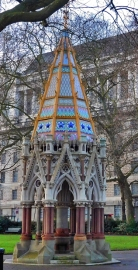 Buxton Memorial
Buxton MemorialTeulon, born in Greenwich, was of French Huguenot extraction. Although trained mostly in the neo-Classical style, it was not long before he became interested in first Tudor and Elizabethan styles, and then in the Gothic Revival style for which he is best known (https://en.wikipedia.org/wiki/Samuel_Sanders_Teulon). Teulon died at his home near Pond Square in Hampstead, which stood where today the Royal Free Hospital stands. The hospital’s neighbour is St Stephens Parish Church, which Teulon designed. It was built between 1869 and ’70. This magnificent edifice built on a corner plot overlooks the hospital, the construction of which unfortunately undermined the church causing it to become unstable and largely unusable. The celebrated Victorian writer, John Ruskin considered the church to have been:
“ …the finest specimen of brick building in all the land” (https://historicengland.org.uk/listing/the-list/list-entry/1130394).
Far less well-known and much more modest than St Stephens, but still within Hampstead, is the small Gatehouse Lodge at the entrance to the Branch Hill Estate near to the top of Frognal. Built in 1868, it is a delightful mix of brickwork and carved white masonry and several features in the gothic style. Its tiled roof is complex with one part of it in the shape of a pyramid and displaying several gables. Overlooking a large field of public allotments, today the lodge serves as a private dwelling. The Gatehouse stands at the entrance to the grounds of an Edwardian building that was built after it. The Edwardian building replaced an earlier mansion, Branch Hill Lodge, in the grounds where it stands. Lord Byron’s wife, Anne Isabella Noel Byron (1792-1860), lived in one of the earlier ‘incarnations’ of the Lodge after her separation from her husband, probably in a building constructed in the 18th century (www.british-history.ac.uk/vch/middx/v...). Lady Byron was involved in the abolition of slavery and was one of the few women to have attended 1840 World Anti-Slavery Convention. JakeSpangler of De Paul University (Chicago, Illinois) noted (https://via.library.depaul.edu/cgi/viewcontent.cgi?article=1274&context=etd):
“Anne Isabella Noel Milbanke, the Lady Byron, was a major proponent of anti-slavery legislation in her lifetime, and as such, her union with Lord Byron may have stoked his views on the matter.”
The proximity of one of Teulon’s buildings to the former residence of an anti-slavery abolitionist brings us neatly to another of Teulon’s creations. This is the Buxton Memorial Fountain, which is close to both the Houses of Parliament and the River Thames, in Victoria Tower Gardens South.
The Slave Trade Act of 1807 abolished slave trade in the British Empire but did not legislate against it elsewhere. Sir Thomas Fowell Buxton, 1st Baronet (1786 –1845), a Quaker who was involved with the Truman brewery and a politician, was engaged actively in a campaign to stop slavery elsewhere in the world, outside the British Empire. The escaped slave and important American anti-slavery campaigner Frederick Douglass (c1818-1895) wrote in an appendix to his autobiography:
“The friends of freedom in England saw in the negro a man, a moral responsible being. Having settled this in their own minds, they … denounced the crime of his enslavement. It was the faithful, persistent, and enduring enthusiasm of Thomas Clarkson, William Wilberforce, …, Thomas Fowell Buxton, …, and their noble co-workers, that finally thawed the British heart into sympathy for the slave, and moved the strong arm of that government in mercy to put an end to his bondage.”
Buxton was important in the fight against slavery. In 1825, William Wilberforce retired, and Buxton succeeded him as leader of the abolitionist movement in the House of Commons. In 1833, Parliament passed the Slavery Abolition Act.
Buxton’s third son, Charles Buxton (1822-1871), a brewer and a Liberal Member of Parliament, decided to erect a monument to his father. An amateur architect, it is believed that he might have had some influence on its design, which was mainly the work of SS Teulon (https://historicengland.org.uk/listing/the-list/list-entry/1066151). Completed at the same time as the American Civil War ended and the abolition of slavery in the USA, it was initially placed in Parliament Square. It was moved to its present location in 1957.
The Buxton Memorial Fountain is a small but colourful, exuberant, firework-like example of the Gothic Revival style. Standing on an octagonal stone base, it is made with a large variety of materials. Its pyramidical roof is covered with patterned tiles in many colours. Four red coloured stone drinking fountains, which no longer function, surround a central speckled granite column that supports a fan-vaulted ceiling, which any cathedral would be pleased to include in its structure. From the memorial there is a fine view of the Houses of Parliament, another superb example of Gothic Revival, but somewhat less flamboyant than Teulon’s much smaller structure.
Charles Buxton dedicated the memorial to his father as well as others involved in the abolition of slavery including William Wilberforce, Thomas Clarkson, Thomas Babington Macaulay, Henry Brougham and Stephen Lushington. Charles was responsible for designing several buildings including his own home, Foxwarren Park in Surrey, which was a florid example of Victorian Gothic Revival. This might explain why he chose Teulon to help design the memorial to the abolitionists.
Both the small buildings I have described are well worth seeing. However, when I saw them, I did not realise that they both had one thing, not architectural, in common: connections with the ending of slavery during the 19th century. Looking at them, I feel that despite what Kenneth Clark suggested, they both borrow from the gothic tradition rather than represent a natural evolution from the gothic style that flourished during mediaeval times.
February 6, 2021
From Hungary to England, Budapest to Hampstead
I ENJOY THE OBSCURE, or, at least, what is new and unknown to me. I am also interested in Hungary and the Hungarians. So, recently, when we were walking along Branch Hill, a road beneath and west of Hampstead’s Whitestone Pond, I spotted a circular blue commemorative plaque that I had not noticed before. Close to a house where the singer Paul Robeson lived for one year, it commemorates a celebrated Hungarian, whom I had never come across before. The plaque reads:
“Alfred Reynolds, Hungarian poet and philosopher lived here 1980-1993”
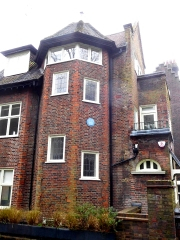
Sadly, the two most knowledgeable Hungarians I knew, who could have told me something about him, the philosopher Imre Lakatos (1922-1974) and one of my father’s co-authors, the economist Peter Bauer (1915-2002), are no longer in the land of the living. So, I have had to resort to that font of all knowledge, Wikipedia, for information about Reynolds, a name that hardly sounds Hungarian to me. Searches of the internet reveal little other biographical information in English apart from what is noted on Wikipedia.
Alfred Reynolds (1907-1993) was born Reinhold Alfréd in Budapest, Hungary (the Hungarians put their surnames before their first names). His mother was Jewish and his father Roman Catholic. After graduating from the University of Leipzig in 1931, he founded a magazine called ‘Haladás’ (‘Progress’), which published the works of various Hungarian poets and was closed by the police soon after it began. Next, he founded another journal, a monthly with leftish tendencies called ‘Névtelen Jegyző’ (‘Anonymous Chronicler’), which was also soon closed by the police. After a brief spell as a member of the Communist Party of Hungary and a spell of imprisonment in Hungary, Alfred moved to the UK, to London, in 1936.
During WW2, Alfred served in the British Army, joining the Intelligence Corps in 1944. When the war was over, he became a leading light in the Bridge Circle, a group of libertarians. The group produced a journal called “London Letter”, some of whose articles were published in a book called “Pilate’s question: Articles from ‘The London Letter’,1948-1963”, which was released in 1964 and contains articles by Reynolds. In 1988, he published another book in English, “Jesus Versus Christianity”. The aim of this book was:
“…to redefine the prevailing image of Jesus of Nazareth. The author considers that Jesus remains a living figure reminding us of our humanity – the kingdom of Heaven within us. He argues that we should free the image of doctrinal encumbrance.” (https://www.goodreads.com/book/show/4932942-jesus-versus-christianity).
Prior to his arrival in England, Reynolds published his writings in Hungarian and those of other Hungarian poets, mostly in the journals he founded. Many of his papers, publications, and other memorabilia are currently on display at the Petőfi Literary Museum in Budapest.
And that is about all I can tell you about Reynolds who spent the last years of his life in a fine house that affords good views over Hampstead Heath. I wonder whether he ever frequented Louis on Hampstead’s Heath Street. Louis was opened as a Hungarian patisserie and café in 1963 by the Hungarian Louis Permayer (died 2017), who fled from Communist Hungary during the Uprising in 1956 (http://budapesttimes-archiv.bzt.hu/2014/10/04/louis-patisserie-a-hungarian-tea-temple-in-the-heart-of-north-london/). Louis still exists and has maintained its original wood-panelled interior décor that owes a lot to traditional Central European taste. It was where my wife and I had our first ‘date’. Today, the café is under different management from what it was when Reynolds moved to Hampstead.
Yet again, whilst walking for pleasure and exercise, I have spotted something that intrigued me because it seemed so unfamiliar and made me want to investigate it. Having discovered that there is not much information easily available about Alfred Reynolds, I am not surprised that I had never heard of him. The plaque commemorating his residence is unusual in that it does not state the name of the organisation or whoever it was that placed it. That adds to the mystery that partially shrouds this Hungarian refugee’s life and his relative obscurity that appeals to me.
February 5, 2021
Fire! Fire!
WALKING ALONG THE ALBERT Embankment upstream from Lambeth Bridge, most people’s eyes will probably be focussed on the River Thames and the lovely views of the Houses of Parliament, Millbank Tower, and the Tate Britain. However, it is worth turning your eyes inland in order not to miss a wonderful example of, in my uninformed opinion, art-deco or, if you are fussy about distinctions, art-moderne architecture, whose decorative façade faces the river. Just in case you were wondering how these styles of architecture from the same time period differ, deco lays emphasis on ‘verticality’ and moderne on ‘horizontality’ (http://theantiquesalmanac.com/chicvssleek.htm). Important as this distinction might be to connoisseurs, the building on Albert Embankment is worth at least a few minutes’ examination.
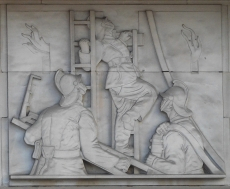
The building in question is the former London Fire Brigade Headquarters, still a functioning fire station. The structure is built of bands of bricks separated by thin horizontal lines of white stone that form the top and bottom frames of the lines of windows, each consisting of lattices of rectangular windowpanes which are wider than they are tall. These design features help define the building’s horizontal sleekness, which is why it is considered by at least one authority (https://historicengland.org.uk/listing/the-list/list-entry/1392337) to be ‘moderne’ rather than ‘deco’. However, it was not this that first attracted us to the building but its decorative panels at various levels and dramatic doorways at ground level.
The doorways, which are wide enough to admit the passage of vehicles are closed with sets of folding doors, consisting of four panels, each of which has a brass window covering (grille) with a geometric design. Some of the building’s decorative panels depict firefighters at work. These are in bas-relief and made of a white coloured stone. These were made by Nicholas Babb (probably Stanley Nicholson Babb; 1873-1957). Other panels, at a higher level, adorn the central section of the façade. These are also bas-relief in white stone but have backgrounds formed of gold coloured mosaic tiles. Created by Gilbert Bayes (1872-1953), who studied alongside Babb at the Royal Academy, their subject matter is borrowed from ancient mythology.
The building itself was designed by EP Wheeler, architect to the London County Council. He was assisted by G Weald. Wheeler also designed the ‘horizontalist’ building on Charing Cross Road in 1939, which was the former home of St Martins School of Art (www.designcurial.com/news/foyles-war-4354398), where my mother worked as a sculptor during the 1960s. The Fire Brigade building was opened by King George VI and his wife on the 21st of July 1937, not a moment too soon, given what was in store for London soon afterwards: the WW2 Blitz, which put great strain on the Fire Brigade.
To the left of the façade, there is a yard in which stands a tall brick tower. This is the so-called ‘drill tower’, used for training firefighters. The building, in addition to having been the Brigade’s headquarters, was also a training centre. The rear of the building, which I have not yet seen, has three layers of balconies, from which members of the public used to be able to observe parades and displays of firefighting skills. Today, the edifice is still used as a fire station but not as the HQ of the Brigade, which is now in Union Street, Southwark.
I enjoy seeing art-deco (and ‘moderne’) architecture. While there are plenty of examples of this in London, which you can spot if you keep your ‘eyes peeled’, the greatest concentration of this style of building that I have seen is in central Bombay in India. Both the Marine Drive and the Oval Maidan in south Bombay are treasure troves for lovers of this style. So, as a lover of this style that broke away from traditional architectural styles in the 1920s and 1930s, I was delighted to have stumbled across the wonderful Brigade building on the Albert Embankment.
February 4, 2021
Where Londoners once had fun
BEFORE THE COVID19 PANDEMIC gripped the world, many Londoners made outings to pleasure grounds such as Legoland, Thorpe Park, and further afield to Disneyland near Paris. During the late 18th century, Londoners seeking entertainment headed for places such as Vauxhall Gardens, Ranelagh (now, the grounds of Royal Hospital Chelsea, site of the Chelsea Flower Show), and Cuper’s (across the Thames opposite Somerset House). These pleasure gardens began to decline, some before and others during the 19th century. However, in their wake, another such place came into existence in Chelsea, Cremorne Gardens.
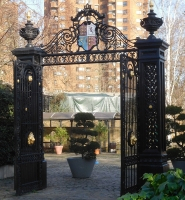
Thomas Dawson, 1st Viscount Cremorne (1725-1813), an Irish landowner, possessed a plot of land on the north side of the Thames, just west of Battersea Bridge. There he had a mansion, Chelsea Farm, which was often visited by King George III, his wife Queen Charlotte, and the future George IV. In 1825, the property came into the possession of Granville Penn (1761-1844), a cousin of Cremorne’s widow. Penn’s claim to fame is that he was involved in the establishment of what is now The Royal Veterinary College in London (www.rvc.ac.uk/about/the-rvc/history). Penn did much to improve the grounds of the estate, but later sold it. The house and grounds were bought in 1831 by Charles Random De Berenger, Baron De Beaufain (www.rbkc.gov.uk/leisure-and-culture/parks/), who created the Cremorne Pleasure Gardens.
The great beauty of the grounds led it to being opened by De Berenger as a public pleasure ground known at first as ‘The Stadium’. De Berenger was:
“… a sportsman and in the grounds opened Cremorne Stadium. Members who paid their two or three guineas could, under the Baron’s instruction, shoot, box, and practise “manly exercises generally” in the grounds.” (https://www.rbkc.gov.uk/pdf/CRA_Historical_Survey.pdf).
Today, there is a Stadium Street located in what would have once been part of Cremorne’s estate.
The Baron died in 1845 and the estate grounds were sold. They were laid out tastefully and the place, opened as a public pleasure ground that attracted large crowds of people seeking pleasure and entertainment, who were willing to pay modest fees for it. The gardens flourished between 1845 and 1877. In 1850, they came under the ownership of Thomas Bartlett Simpson, who also purchased Ashburnham House (an 18th century edifice) on the west side of the estate, which he used to house some of his visitor attractions. The grounds offered visitors many attractions including dancing; meals; secluded areas; firework displays; theatres for farce and vaudeville; ballets; puppet shows; trapeze artists; tight-rope walkers; a maze; and balloon ascents.
In his 1880’s “Old and New London”, Edward Walford describes some of the exploits with balloons, which were not without excitement. In 1839, whilst the gardens were owned by De Berenger, a Mr Hampton equipped with a parachute ascended two miles above the ground with a balloon and then descended to the ground with his parachute. Some years later, Vincent De Groof ascended from Cremorne Gardens in a contraption, designed to help him fly, suspended from a balloon. After reaching a high altitude, something went wrong and poor De Groof fell to his death.
By the 1870s, the Cremorne Gardens were becoming disreputable, especially becoming notorious for prostitution. After they closed (for financial reasons), the land became used for building houses and other buildings including the Lots Road Power Station.
In about 1846, the artist JMW Turner (1775-1851) moved into a house by the river on what is now Cremorne Road, close to Cremorne Gardens and to the Cremorne Pier. He constructed a kind of gallery on its roof, from which he could sit and observe the changing light on the river. According to a biography by Peter Ackroyd, Turner was unwell whilst he lived there, suffering from dental problems that caused him to lose all of his teeth, and consequent dietary-related illness. He remained in Cremorne Road until the last year of his life and died there.
Today, little remains of Cremorne Gardens except a few street names and a small park close named Cremorne Gardens next to the river. This delightful, small open space has a paved section as well as a lawn. It is a tiny fragment of the original Cremorne Gardens but a fitting memorial to a place that provided entertainment for Londoners over many years. A couple of piers project into the river. These were originally landing stages for visitors arriving at the Gardens by river boat. Another souvenir of the heyday of the Gardens is a pair of wrought iron gates that stand in the present plot, but not in their original position, now built over. Small though it is, with its superb views of the Thames, the present Cremorne Gardens is a pleasant place to visit, within a short distance from the fashionable Kings Road.
February 3, 2021
In memoriam: do not pull it down
TEARING DOWN STATUES or defacing them is nothing new, as some might believe after hearing about dunking Edward Colston’s toppled statue into a river in Bristol.
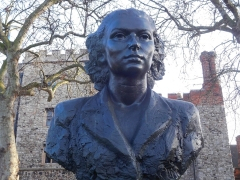 Violette Szabo
Violette SzaboWhen I visited Albania in 1984, I saw statues of Josef Stalin and the Albanian dictator Enver Hoxha prominently placed in public spaces. Neither of these two gentlemen can be seriously considered to be God’s best gifts to humanity. Many of their actions caused great fear and suffering in both the former USSR and in Albania.
In 1991, Albania’s long (1944-1991) Communist regime crumbled ignominiously. In February 1991, citizens of Albania’s capital, Tirana, attached cables to a huge statue of Enver Hoxha, an admirer of Stalin, and pulled it down. Many of the police guarding the huge monument to repression assisted the people to cause this bronze statue to topple to the ground.
Years later, in 2016, we visited Albania. In the centre of Tirana, there is a national museum of art, which was present when I visited the city in 1984. Back then, and even in 2016, there was a good collection of fine works created in the Social Realism style, so popular amongst Communist regimes. After seeing the gallery in 2016, we happened to bump into one of the museum’s curators. I showed him a picture of a sculpture I had taken in 1984 and asked him if he recognised it. Without answering, he invited us to follow him to a yard at the rear of the gallery.
There, in the yard, stood the sculpture I had photographed in 1984. More interestingly, it was not alone. It stood next to a giant statue of Lenin and another one of Stalin and another large object wrapped in cloth tied down with ropes. The curator explained that these statues, although they depicted people whose ideas and actions had done much harm to the Albanian people, were valuable works of art, not simply because of their great scrap metal value but, more importantly, they helped record the country’s history. In addition, he explained that they were fine examples of their genre. The bundled-up object standing in that yard was, he explained, too sensitive to uncover as it would upset many people viewing it. It was part of an enormous statue of Enver Hoxha, who had not yet been forgiven by many Albanians. Clearly, Lenin and Stalin were thought to be less disturbing as they were not covered up, but sufficiently upsetting to be confined to a relatively unvisited yard behind the gallery open to the public.
Both Trafalgar and Parliament Squares in London contain statues that might cause offense to those whose knowledge of history is more than superficial, yet their actions have not always been 100% reprehensible. Fortunately for these monuments, many of the kind of people who might be inclined to topple statues do not usually read much detailed history.
There are some statues or monuments, which remember people, whose actions cannot rationally be called into question. One of these is that of Edward Jenner (1749-1823), whose work formed the foundation of something on which we are currently becoming extremely dependent: vaccination. Only someone out of his or her mind would consider pulling down or defacing his statue.
Recently, when strolling along an embankment, I spotted a monument close to the River Thames outside Lambeth Palace. Erected in 2009, it commemorates the Special Operations Executive (‘SOE’), whose covert activities in no little way helped to bring about the defeat of Nazi Germany’s forces during WW2. The plinth with metal commemorative plaques is topped with the head of a woman with high cheekbones, a serious, determined face, and luxuriant curly hair, tied back. She stares out across the River Thames toward the Houses of Parliament. The bust depicts Violette Reine Elizabeth Szabo (1921-1945), whose actions behind enemy lines in France were designed to sabotage German military activity. She was one of many women including Noor Inayat Khan (1914-1944), of Indian aristocratic heritage, who risked and lost their lives to assist in the defeat of a repressive regime.
SOE was staffed by both men and women of many nationalities, and their bravery is recorded on this simple memorial outside Lambeth Palace. Although simple in design, the expression depicted in the face of Violette Szabo gave me a feeling of the great determination of those brave souls who gave up their lives in horrific circumstances. They did so in the hope, fulfilled, that we could enjoy life in Britain and elsewhere without having to bear the burden of inhumane dictatorial rule.
Unlike Stalin and Hoxha, statues of the purely benevolent such as Jenner and Szabo should be allowed to stand undisturbed for ever, well, at least, so long as they can survive London’s ever-changing weather conditions and pollution.
February 2, 2021
Where there are dolphins
I HAVE NEVER VISITED MOSCOW, but I imagine that the huge, rather forbidding looking apartment block on Grosvenor Road facing the River Thames, would not look out of place in the Russian city. Covering seven and a half acres of land, built with twelve million bricks and almost seven thousand external window units, and containing at least twelve hundred flats, this mammoth building complex, which has been home to many of the famous and infamous, was completed in late 1936. This enormous residential complex is called Dolphin Square.
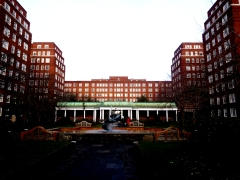
Maps surveyed in 1869 and 1913 reveal that the land on which Dolphin Square was built, which is west of St Georges Square, used to be the site of the several long buildings that together made up the Royal Army Clothing Department and its storage depots. Before that, the land was occupied by the work premises of the developer and builder Thomas Cubitt (1788-1855), who built much of Belgravia and Pimlico. A few years after his death, the army leased the site and the depot stood there until 1933, when the lease reverted to the Duke of Westminster (https://en.wikipedia.org/wiki/Royal_Army_Clothing_Depot).
An American firm, Fred F French Companies, bought the freehold of the former army clothing compound, and then, discovering it had insufficient funds to develop it, sold it on to Richard Costain Ltd. Costain commissioned the architect Stanley Gordon Jeeves (1888-1964), whose other works include the now demolished Earls Court Exhibition Centre and the still standing large, art-deco Latimer Court at Hammersmith, to design the residential complex that exists today. Writing soon after it opened, the writer AP Herbert (1890-1971) wrote a book extolling the virtues of Dolphin Square. He wrote that it is:
“…a city of 1,250 flats, each enjoying at the same time most of the advantages of the separate house and the big communal dwelling place …”
Commenting on the fact that the complex included a restaurant, he wrote:
“…fortunate wives will not have enough to do. A little drudgery is good for wives, perhaps. The Dolphin lady may be spoiled.” (quotes from www.theundergroundmap.com/article.html?id=2792)
From outside the building, Dolphin Square looks monolithic and forbidding. However, on entering the huge courtyard within it, this impression changes. For, the courtyard contains a lovely garden, which was designed by Robert Sudell in about 1937 (https://historicengland.org.uk/listing/the-list/list-entry/1455668). Though much modified since then, the formal garden retains much of the original design concept including an axial avenue lined with chestnut trees. Appropriately, the middle of the garden is adorned with a fountain with three sculpted dolphins. Created by the sculptor James Butler (born 1931), this was placed in 1987 to replace an earlier fountain. This pleasant garden would be one good reason to entice me to live in this extraordinarily massive complex.
As mentioned already, Dolphin Square offers its residents a restaurant. It also contains an arcade of shops, a café, a gymnasium, a swimming pool, a laundrette, underground parking, a bar, a brasserie, a hotel, a tennis court, and more. And all of this is within a short walk of Westminster and the Houses of Parliament. This proximity to the centre of government means that many MPs have made use of Dolphin Square as their London ‘pads’.
Apart from politicians, including Harold Wilson, William Hague, David Steele, and many others, Dolphin Square has been home to people of fame and notoriety. According to an article in Wikipedia, some of these include Oswald Mosley and his wife Diana Mitford; the novelist Radclyffe Hall; Christine Keeler and Mandy Rice-Davies; the comedian Bud Flanagan; the spy John Vassall; and the tennis player Rod Laver. Princess Anne lived in Dolphin Square briefly in 1993, General de Gaulle based his Free French Government in part of the Square in WW2, and Sarah, daughter of Sir Winston Churchill, was:
“…evicted from the square for hurling gin bottles out of her window.” (https://www.bbc.co.uk/news/magazine-33785352).
It seems that a fascinating book about the residents of Dolphin Square is waiting to be written.
I had passed Dolphin Square plenty of times before entering its garden recently, but until now I had no idea that this far from attractive building was home to such a fascinating range of people nor that it contained such a fine garden. Just as one should not judge a book by its cover, it is a mistake to judge Dolphin Square from its exterior.
February 1, 2021
Finding Boy George and Bliss in north London
DURING THE COVID19 PANDEMIC, when travelling far afield has been discouraged for public health reasons, I have been exploring one of my old haunts, Hampstead, and have been becoming increasingly more interested in its attractions and historical associations. I invite you to join me on one of my rambles through a part of this intriguing area of north London.
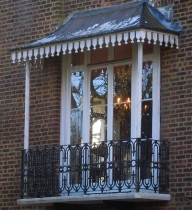 Detail of house where Sir Arthur Bliss lived
Detail of house where Sir Arthur Bliss livedEast Heath Road runs eastwards, then southwards, relentlessly downhill from Hampstead’s Whitestone Pond towards South End Green, close to the Royal Free Hospital. The road marks the eastern edge of the spread of Hampstead into Hampstead Heath. Except for three well separated blocks of flats, there are no buildings on the eastern side of the Road. A winding lane leads off the road to the small settlement of the Vale of Health, an enclave which is surrounded by the Heath.
The block of flats facing Whitestone Pond at the top end of East Heath Road (‘EHR’) is called Bell Moor. Built in 1929, this edifice stands on the site of the home where the historian Thomas J Barratt (1841-1914) lived from 1877 to 1914. He was Chairman of the Pears soap manufacturing company and a pioneer in brand marketing as well as a historian of Hampstead. His “Annals of Hampstead”, published in 1912, is a detailed, monumental, beautifully illustrated, three volume account of Hampstead’s history. In addition to a plaque commemorating Barratt on Bell Moor there are two others. One of them records that the great conductor Sir Thomas Beecham (1879-1961) lived there from 1937-1941 and the other is placed to record that the surface of the soil at Bell Moor is 435 feet above sea level or 16.5 feet higher than the top of the cross on the dome of St Paul’s Cathedral.
Moving downhill, all the older houses are on the west side of East Heath Road. The writer Katherine Mansfield (1888-1923) and her husband, the critic John Middleton Murry (1889-1957), lived at the end of a short Victorian terrace, at number 17 EHR (formerly ‘Portland Villas’). Next door to this, there is a picturesque ivy-clad building, Heath Cottages, with one wall covered in wood cladding and a small balcony above one of its centrally placed pair of front doors. Barratt included a drawing of this building in his book but makes no comment about it.
A large house, The Logs, with an extravagant brick tower, eye-catching but not attractive, is reached further down EHR. This was built in 1868, designed by JS Nightingale for the drainage and water supply engineer and Justice of the Peace for Middlesex Edward Gotto (1822-1897; http://www.icevirtuallibrary.com/doi/pdf/10.1680/imotp.1897.19422). It has also been home to the comedian Marty Feldman and later the popular musician Boy George. The Logs neighbour is Foley House, which I have described elsewhere (https://adam-yamey-writes.com/2021/01/15/a-house-a-spa-and-grays-anatomy/).
Proceeding down EHR, we pass several large brick-built terraced houses until we arrive at the corner of a lane called Heathside. A large house on the corner of this and EHR bears a plaque that notes that the composer Sir Arthur Bliss (1891-1975) lived here in East Heath Lodge from 1929 to 1939. It was in this house that the painter Mark Gertler (1891-1939) painted the composer’s portrait in 1932 (https://www.npg.org.uk/collections/search/portrait/mw07115/Sir-Arthur-Bliss). During his residence on EHR, his musical compositions began to be come less avant-garde and he became a musical successor to the composer Edward Elgar. I wonder whether living in a house with views over Hampstead Heath might have influenced his change in composing style.
East Heath Lodge appears to have been divided into two residences. Bliss occupied the half of the building next to the Heath. It was built in about 1785 by the local builder Henry White and modified in about 1820 (https://historicengland.org.uk/listing/the-list/list-entry/1342097). A large bell hangs under a metal canopy outside the western half of the building, which bears the name ‘South Lodge’. West of East Heath Lodge along Heathside, there are some large cottages built in about 1814. South of Bliss’s former home, EHR is flanked to the east by a large public car park and to the west by a triangular green space whose apex is at the point where Willow Road meets the southern extension of EHR, South End Road. Just before it does that, EHR meets the eastern end of Downshire Hill soon before it crosses Willow Road.
Number 2 Willow Road, a modern looking two-storey building can be seen across the grass from EHR. Modern it looks although it was designed and built by the architect of Trellick Tower Ernö Goldfinger (1902-1987) in 1939. In 1942, Goldfinger, who had Marxist sympathies, hosted an exhibition of leading artists in his new home in order to raise funds for “Aid to Russia” (www.nationaltrust.org.uk/features/who-was-ern-goldfinger). Now owned and maintained by the National Trust, it is well worth visiting this superbly designed living space. Incidentally, Goldfinger’s house was constructed on the site of some 18th century cottages that were demolished to make place for it.
South of Willow Road, EHR becomes South End Road. The houses lining this road’s western side, but set well back from it, are in complete contrast to Goldfinger’s residence just north of them. Each of the houses is separated from the pavement by long strips of beautifully cared for gardens. Most of the dwellings have names: Hartley House (no. 103), where the architect Oswald Milne (1881-1968) once lived; Heath Cottage (no. 101); Guernsey Cottage (no. 93), home of the 19th century translator of “Heinrich Heine’s Book of Songs”, JE Wallis; Bronte Cottage (no. 89), home of the artist Mary Hill (1870-1949); St Johns Cottage (no. 87); Rose Cottage; Leighton House (no. 73), and Russell House (no. 71), an early 19th century house with a late 19th century enclosed veranda by Charles Francis Annesley Voysey (1857-1941), one of his earliest projects. Beyond these, there is Keats Grove, across which a line of shops commences. The architectural historian, Nikolaus Pevsner, who lived in Hampstead, described this row of buildings as:
“… a pleasant irregular sequence of early c19 houses.”
And that is a good description of them.
South End Road, the continuation of EHR, becomes Fleet Road and heads south east towards Chalk Farm. We end our ramble at Pond Square, where once there was a cinema, its site now occupied by Marks and Spencer’s superb food store. Just north of it is Hampstead Heath Overground Station, which is close to a pub with fake half-timbering called the Garden Gate. In 1855, a pub on this site was called ‘The Perseverance’. It was renamed ‘The Railway Tavern’ by 1871 and got its present name more recently. Closed at present because of the covid19 pandemic, the best place to refresh yourself, after walking down from Whitestone Pond and enjoying the varied architecture along the way, is the Matchbox Café next to the small, cobbled bus yard in Pond Square. Its friendly owner Mirko prepares good hot drinks and sells a variety of tempting snacks. And before you leave the area, pick up some great fruit and vegetables from the well[stocked stall next to the station ticket office.
January 31, 2021
Honouring a Hindu hero in London
MI5 WORKS TO HELP protect our democracy in the UK. Its architecturally unflattering headquarters stand looming above the southern end of Vauxhall Bridge. A few yards downstream from it, and directly facing the main entrance of the Tate Britain across the river, there is a small grassy triangle close to the river. In the middle of the green space, there is a bust on a pedestal. The bust depicts a man with a moustache, who is wearing two chunky necklaces and what looks like a bejewelled turban. This is a monument to Basaveshvara, who lived between 1134 and 1168 (actually, these dates are not certain: he might have lived c1106-1167). A panel on the side of the pedestal notes that he was:
“Pioneer of Democracy and Social Reform”
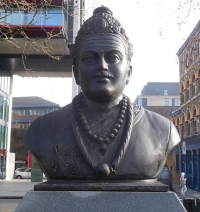
Various people and organisations supported the creation of this monument to someone of historical importance but until now unknown to me and, I would guess, to many other people wandering past the bust. As one of the organisations involved in its creation was The Government of Karnataka (in southern India), I reached for my tattered copy of “A History of Karnataka” (edited by PB Desai), which I picked up in the wonderful Aladdin’s cave of a bookshop, Bookworm, in Church Street, Bangalore, a city which I visit often. It has 8 index entries for Basaveshwara, who is also known as ‘Basava’, ‘Basavanna’, and ‘Basavaraja’, all of these being transcripts from various Indian language alphabets.
Basaveshwar was born of Shaivite Brahmin parents at Bagevadi, which is now in the Bijapur district in the northern part of Karnataka. His name is derived from the Sanskrit word ‘Vrishabha’, the divine bull, Nandi, who carries the god Shiva. Early histories (the Puranas) described him as an incarnation of the god Shiva rather than a human being, but it is considered that he was certainly a real person. A devotee of Shiva, Basaveshwara was well-versed in both Kannada and Sanskrit learning. He was brought up in a social milieu in which people blindly adhered to the dogmas and rituals of Vedic Hinduism without bothering to understand the true spirit of religion. Desai wrote:
“Basava’s mind revolted against these ills and he decided to defy the existing order of things.”
After receiving the sacred thread, very roughly speaking a Hindu equivalent of the Jewish Bar-mitzvah or the Christian confirmation, Basaveshwara went to the Kudama Sangama, a temple complex at the confluence of the Rivers Krishna and Malaprabha. In 2011, long before I had ever heard of Basaveshwara, we stopped briefly at the Sangama on our way from Hospet to Bijapur (now named ‘Vijayapura’), both in Karnataka. When we were there, the rivers had dried up and we saw signs advising visitors to beware of crocodiles.
Basaveshwara remained at the Sangama for about 12 years. In his time, as it is now, the Sangama was much visited by people from all walks of life. There, he met many scholars and learned men from all schools of Hindu belief. Eventually, Basaveshwara travelled to Mangalavada, the headquarters of Bijala II (c1130-c1167), the feudatory governor of the Kalachuri family (of the Chalukya dynasty). Soon, Basaveshwara became the Chief Treasurer of Bijala’s court. It was then that Basaveshwara:
“… started his new movement of religious and social reforms, treating all devotees of Siva [i.e. Shiva] as equal in all respects without the traditional distinctions of castes, communities and sects.” (Desai)
After about 20 years, BASAVESHWARA moved to Kalyana, the capital of Bijala, where his reformist ideas gained a great following. Bijala II, who had become suspicious of Basaveshwara, began crushing the movement inspired by Basaveshwara’s radical ideas that seriously threatened the traditional hierarchy that favoured the Brahmins, as well as advocating some hitherto unknown equality of men and women in spiritual aspects of life. For example, Basaveshwara sanctioned a marriage between the son of an ‘untouchable’ and the daughter of a Brahmin. Upset by this, Bijala sentenced the couple to death. Basaveshwara’s followers then plotted to assassinate Bijala, an act of which Basaveshwara disapproved. Realising that he could not restrain his angry followers, Basaveshwara retreated to Kudama Sangama, where he died. Bijala was murdered soon afterwards. Later, Basaveshwara became venerated as a (Hindu) saint.
Basaveshwara believed:
“…that every human being was equal, irrespective of caste and that all forms of manual labor was equally important.” (https://en.wikipedia.org/wiki/Basava).
These ideas sound familiar to those versed in the history of Mahatma Gandhi, who lived many centuries after Basaveshwara. Yet, Basaveshwara is relatively unknown compared with Gandhi. Basaveshwara was certainly a reformer as is stated on the base of his bust near Vauxhall Bridge and his radical ideas were undoubtedly democratic when considered in relation to the time when he lived. So, it is quite appropriate that from his bust, there is a clear view of the Houses of Parliament, a home of democracy.
The bust on the embankment was erected by Dr Neeraj Patil, born in Karnataka, a member of the Labour Party and Mayor of the London Borough of Lambeth 2010-2011 and Dr Anagha Patil. It was unveiled in November 2015 by the current Prime Minister of India, Shri Narendra Modi. It is appropriate that Modi inaugurated this memorial as his parents were members of what was officially recognised a socially disadvantaged community, whose emancipation would surely have been approved by the reformer Basaveshwara. And what is more, Modi is one of the first, if not the very first, of the Indian Prime Ministers, all democratically elected, who was not from a ‘high’ caste or social class such as Brahmin, Kayastha, and Rajput, and has completed at least one term of office. So, I feel that Basaveshwara does deserve a place within sight of the ‘Mother of Parliaments’.
January 30, 2021
Gushing from beneath the ground
AT SCHOOL, MY CHOSEN SPORT was cross-country running. Twice a week I spent an hour or so doing this in the grounds of Kenwood and the part of Hampstead Heath near to Highgate in North London. I have written about this before (https://adam-yamey-writes.com/2020/06/14/my-sporting-life/), but there is one aspect of it that I did not cover. Once a year, those who did cross-country running were accompanied by a teacher, Mr Bowles, who believed that getting covered in mud was an essential part of this form of exercise. I did not share his odd belief. There was one place on the Heath where filthy red coloured mud was guaranteed. This was at a point 410 yards south east of the centre of the grand south facing façade of Kenwood House and a few yards northwest of The Stock Pond, one of the series of Highgate Ponds.
The reason that this spot, favoured by Mr Bowles, was and still is, always sodden is that it surrounds a natural spring, which issues from a cylindrical stone well-head covered with stone carvings. These include depictions of a squirrel, a fish, and the head of a man with a luxuriant moustache. The water issues from a pipe emerging from the man’s mouth and then drops into a carving of a scallop shell before some of it falls into a drainage grid and the rest all over the place.
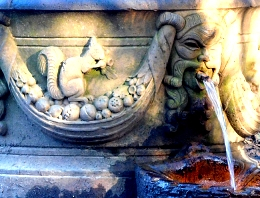
This well head is called Goddisons Fountain. It was constructed in 1929 (https://insearchofholywellsandhealingsprings.com/2019/04/19/the-healing-springs-of-hampstead/) and named in honour of Henry Goddison, who campaigned vigorously for saving Kenwood and Hampstead Heath from being built on and for preserving it for the use of the public. It is not known whether there was a spring on this spot prior to 1929, but it is not unlikely that there was.
Goddisons Fountain is the last surviving spring issuing chalybeate (iron rich) water in the Hampstead/Highgate area. Prized for its supposed curative properties, especially during the 18th century, there were several springs issuing this kind of mineral water in Hampstead. A fine example of a now disused spring well-head can be seen at the eastern end of Well Walk in Hampstead. It was for public use and located across the road from the Hampstead spa that thrived during the 18th century (https://adam-yamey-writes.com/2021/01/15/a-house-a-spa-and-grays-anatomy/).
If, unlike many who stroll on the Heath, you do not wish to try the chalybeate water issuing copiously from Goddisons fountain, the next nearest source of this once highly prized water is about 47 miles south east in The Pantiles at Royal Tunbridge Wells in Kent.
The water flowing from Goddisons Fountain is one of many sources of the water in the Highgate Ponds, which include (descending the slope from Kenwood) the Wood Pond; the Thousand Pound Pond with the trompe l’oeil bridge designed by Robert Adam; the Stock Pond which is directly below Goddisons Fountain; the Ladies’ Bathing Pond; the Bird Sanctuary Pond, where I spotted a heron; the Model Boating Pond, where I saw no boats; the Men’s Bathing Pond; and Highgate Number 1 Pond. The water from the topmost pond flows through the lower ones sequentially. Most of these ponds were dug before the 18th century as reservoirs for London’s water. They were kept full by damming the Hampstead Brook, a tributary of the now hidden River Fleet, in 1777. In addition, numerous streams in the grounds of Kenwood and on Hampstead Heath were diverted to keep them topped up. Now, the ponds form a valuable publicly accessible leisure amenity. Hardy souls gain great enjoyment in swimming in the gender segregated open-air ponds, whose waters are not subjected to any purification or disinfection procedures. During the present covid19 ‘lockdown’, it is only wildfowl that can enjoy their water.
As we looked at Goddisons Fountain today in late January 2021, I recalled my muddy encounters with it in the company of Mr Bowles and realised that I had not seen it since early 1970, that is just over half a century ago. And it was not until I wrote this that I learned that the fountain is the last surviving chalybeate spring in the part of the world, where I was brought up.



